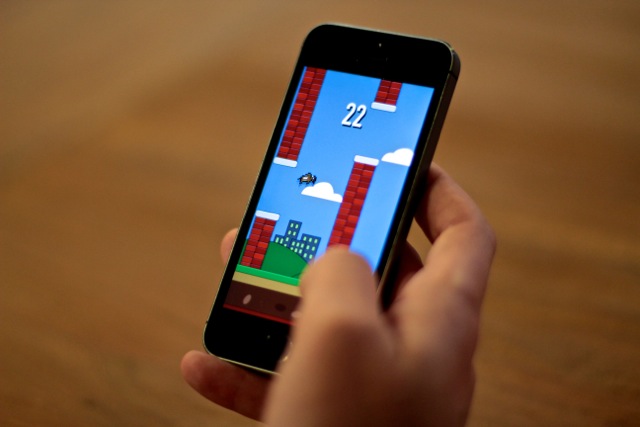Everyone is building “Flappy Bird” clones now, even Apple Design Award-winning app developers like Tapity, apparently. The company, known as the makers of well-built and beautifully designed apps like Languages, Grades 3, and Hours, recently explained why they felt the need to throw their hat into the highly-pixelated ring, with this week’s launch of their latest app, “Buffalo Wings,” another contender for the throne abdicated by “Flappy Bird” creator Dong Nguyen.
In a blog post, Tapity founder Jeremy Olson offers a host of explanations for “Buffalo Wings,” including, well yeah, it might make them a little money thanks to its in-app ads. But Olson tells us that his main motivation at the time the project began was to fill the gaping hole that appeared in the “Flappy Bird” market when Nguyen first pulled his creation from the App Store.
Clearly, that hole has been filled since, as the top charts are now littered with “Flappy Bird” clones, including “Flappy Wings” (#1), “Hoppy Frog” (#2), “Flying Cyrus – Wrecking Ball” (#5), “Splashy Fish” (#6), and many, many, many others.
But, says Olson, at the time he came up with the idea, the hole was being filled by a number of “terrible” clones. “I just couldn’t believe it. I wanted to see if quality meant anything in that market,” he explains. (So far, it seems to have not).
And thus began Tapity’s experiment.
After getting things started, however, building the clone became a family project, where Olson’s dad ended up doing the app’s audio, his high school senior sister Susanna did the app’s funny buffalo facts, and his other three sisters tested the app and helped him hone the variables to make it a balance of being hard, but not too hard.
Olson also taught his 10-year old brother Zach how to code, and Zach ended up worked on programming some of the physics in the game, as well as designing the pixelated buffalo, the Tapity blog post details.
Since the effort was meant to be a fun, little side project, we asked Olson why the company felt the need to publicize its efforts. He told us that not only is learning and sharing an important part of Tapity’s culture, they also felt they needed to explain “why on earth they were doing it in the first place.” The reaction, as it turns out, hasn’t been wholly positive and supportive. Olson says he’s “received pretty strong negative feedback from some people,” in fact.
Since many of the clones on the market, and others riding the wave involving dumbed-down applications, come from iffy developers and even those known as outright scammers, Tapity’s experiment also allows them to share some more legitimate insight into the state of the “Flappy Bird” clone market today, and Apple’s rules surrounding these new creations.
While Apple did start rejecting applications with “Flappy” in the title earlier this month, its policing of these clones has been more nuanced than blanket rejections, we learned. Tapity’s experience confirms this, as Olson notes that Apple isn’t allowing apps to use “Flappy” in their meta data.
“So there is no chance of riding the ‘flappy’ search wave, like most clones have,” Olson explains.
There are still an abundance of clones that use “flappy” in their meta data, of course, but there are also a number of top apps that have recently changed their names to meet Apple’s new guidelines, including “Splashy Fish” and “Fly Birdie” for example.
“I think this is generally a good thing because it levels the playing field,” Olson adds. “Hopefully the apps that rise to the top will no longer simply be the ‘flappy [something],’ but the apps — flappy-look-alike or not — that spread by word of mouth because of real quality,” he says.
Like, perhaps, “Buffalo Wings?”































Comment